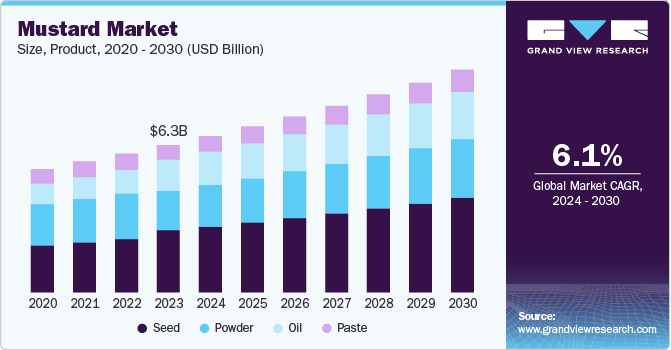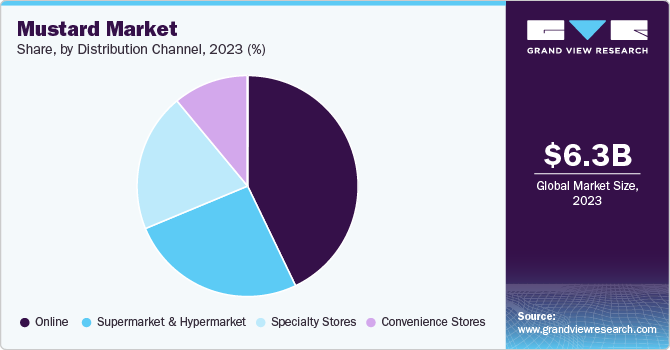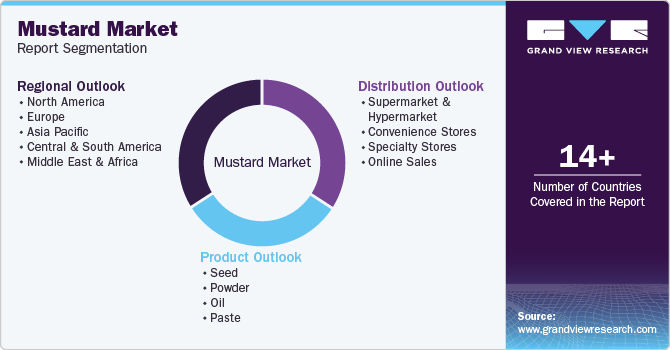- Home
- »
- Consumer F&B
- »
-
Mustard Market Size, Share & Growth Analysis Report, 2030GVR Report cover
![Mustard Market Size, Share & Trends Report]()
Mustard Market Size, Share & Trends Analysis Report By Product (Seed, Powder, Oil, Paste), By Distribution Channel (Online Sales, Convenience Stores), By Region, And Segment Forecasts, 2024 - 2030
- Report ID: GVR-4-68040-483-4
- Number of Report Pages: 80
- Format: PDF, Horizon Databook
- Historical Range: 2018 - 2023
- Forecast Period: 2024 - 2030
- Industry: Consumer Goods
Mustard Market Size & Trends
The global mustard market size was estimated at USD 6.3 billion in 2023 and is expected to grow at a CAGR of 6.1% from 2024 to 2030. Consumers are increasingly aware of the health benefits associated with mustard, including its potential anti-cancer properties and nutritional value. Mustard seeds are rich in essential nutrients, which has led to a rise in demand for mustard-based products as part of a healthy diet. Mustard seeds are rich in essential nutrients, including proteins, fiber, vitamins, and minerals such as erucic acid and tocopherols. These components contribute to various health benefits, including improved digestion, reduced inflammation, and enhanced skin health. Companies are investing in research and development to create innovative mustard-based products, including gourmet mustards and functional foods with added health benefits. This includes mustard extracts and oils with enhanced nutritional profiles.

Mustard seeds are integral to various cuisines worldwide, particularly in Asia, where they are used in cooking oils and condiments. The demand for mustard-based products like sauces and dressings is rising due to culinary innovation and the popularity of gourmet foods. The expansion of the fast-food industry has significantly boosted the demand for mustard condiments, as they are commonly used in many fast-food items.
Mustard is a significant oilseed crop contributing substantially to global vegetable oil production. Its status as one of the top three sources of vegetable oil globally emphasizes its economic importance and market growth potential. Mustard oil is known for its high content of essential fatty acids, vitamins, and antioxidants, making it a popular choice for health-conscious consumers. Its anti-inflammatory and antimicrobial properties contribute to its appeal in both cooking and therapeutic applications. As consumers increasingly seek natural and healthy cooking oils, mustard oil is often chosen as a healthier alternative to sunflower or palm oil. In regions like India, mustard oil is a staple cooking ingredient, deeply embedded in culinary traditions. Its distinct flavor enhances various dishes, driving consistent demand.
Mustard powder is widely used as a flavoring agent in various food products, including sauces, dressings, and condiments. Its versatility enhances the taste of dishes, making it a staple in kitchens worldwide. Consumers are growing more accepting of ethnic flavors, leading to increased mustard powder usage in international cuisines. This trend is powerful in regions with diverse culinary practices.
The mustard market is highly dependent on a stable supply chain for raw materials, which includes timely transportation and distribution. Disruptions caused by geopolitical tensions, natural disasters, or global pandemics can lead to significant delays, increased costs, and reduced product availability. Mustard seeds are perishable and require efficient handling to maintain quality. Any delays in the supply chain can result in spoilage or degradation of quality, further limiting market growth.
The production of mustard oil and other derivatives involves multiple stages-cleaning, dehulling, pressing, and refining-each requiring specialized equipment and substantial energy input. These high processing costs can diminish price competitiveness compared to alternative oils. The presence of superior edible oil alternatives like sunflower, groundnut, and flaxseed oil poses a significant challenge to the mustard market. Due to their perceived health benefits, these alternatives often have established market shares and consumer preferences. As consumer tastes evolve, there is a risk that demand may shift towards these substitutes if they are perceived as more favorable in terms of flavor or health benefits.
Product Insights
The mustard seeds market segment was the largest and had a revenue of USD 2.65 billion in 2023. It is expected to grow at a CAGR of 6.2% over the forecast period. Mustard seeds contain essential nutrients, including proteins, fiber, vitamins, and minerals such as erucic acid and tocopherols. These components contribute to various health benefits, including improved digestion and reduced inflammation, making mustard seeds popular among health-conscious consumers. The antimicrobial properties of mustard seeds enhance their appeal in natural remedies and preventive healthcare, further boosting their demand.
Mustard seeds are widely used in various cuisines as flavoring agents in sauces, dressings, and condiments. Their versatility enhances their market appeal as they can be incorporated into various food products. The rise of gourmet foods has led to innovative product offerings, such as specialty mustards and mustard-infused products, catering to consumers seeking unique flavors.
The Asia Pacific region, particularly India, is a major producer and consumer of mustard seeds. Traditional culinary practices and increasing urbanization contribute to sustained demand in this region. Regions like the Middle East and Africa are witnessing increasing demand due to expanding food processing industries and rising awareness of the health benefits associated with mustard seeds.
The mustard oil market is expected to exceed USD 2 billion by 2030, primarily due to its demand as an edible oil in F&B applications. The growing demand for mustard oil is driven by several key factors reflecting consumer preferences and market dynamics. One of the primary drivers is the increasing awareness of the health benefits associated with mustard oil, which is rich in monounsaturated fatty acids, omega-3 fatty acids, and antioxidants. These components are linked to improved heart health and anti-inflammatory effects, making mustard oil an appealing choice for health-conscious consumers. Additionally, the rising popularity of ethnic and Asian cuisines has further fueled demand, particularly in regions like India, where mustard oil is a staple cooking ingredient.
Moreover, expanding the food service sector, including restaurants and fast-food chains, has contributed to higher demand for mustard oil as a versatile cooking medium. The ongoing trend towards natural and organic products also significantly drives market growth, as consumers increasingly seek oils that offer flavor and nutritional benefits without artificial additives.
Economic factors also contribute to the growing market; mustard oil is often more affordable than other edible oils, making it an attractive option for consumers in developing countries with large middle-class populations. Government initiatives to stabilize prices and boost domestic production in key markets like India further support the mustard oil sector. As these trends evolve, the mustard oil market is expected to experience sustained growth driven by health consciousness, culinary versatility, and economic accessibility.
Distribution Channel Insights
Online mustard product sales are expected to generate over USD 2.7 billion in revenue in 2023. The role of online distribution in the mustard market has become increasingly significant, driven by changing consumer preferences and the growing demand for health-oriented products. Online distribution channels have transformed how mustard products reach consumers. E-commerce platforms allow brands to tap into a broader audience, facilitating access to various mustard products without geographical constraints. This shift is essential in a competitive market where traditional retail channels like hypermarkets and grocery stores complement online sales strategies. Brands that effectively utilize online marketing and distribution enhance visibility and cater to the diverse needs of health-conscious consumers seeking convenience.
Supermarkets and hypermarkets were a vital distribution channel for the mustard market. Supermarkets and hypermarkets play a pivotal role in the market growth by serving as primary distribution channels for mustard products. These retail formats provide consumers with easy access to a wide variety of mustard options, including seeds, oils, sauces, and prepared condiments. The convenience of one-stop shopping in supermarkets and hypermarkets caters to busy lifestyles, allowing consumers to purchase mustard alongside other grocery items. This accessibility is essential as it supports impulse buying and encourages consumers to try different mustard varieties or brands they might not have considered otherwise.

Moreover, the increasing trend of urbanization has led to a higher demand for these retail formats, as they are often located in densely populated areas where consumers prefer the convenience of nearby shopping options. Supermarkets and hypermarkets also leverage promotional strategies, such as discounts and attractive displays, to enhance product visibility and drive sales. Additionally, convenience stores contribute to market growth by offering mustard products in easily accessible locations, catering to on-the-go consumers seeking quick meal solutions or snacks that incorporate mustard.
Regional Insights
Due to changing consumer preferences, the North America mustard market exceeded USD 1.7 billion in 2023. There is growing consumer awareness of the health benefits of mustard products, particularly mustard oil, which is rich in monounsaturated and polyunsaturated fats. These healthy fats are known to lower harmful cholesterol levels and promote heart health, making mustard oil an attractive option for health-conscious consumers. Additionally, the rise of functional foods-those that offer health benefits beyond basic nutrition-has led to greater interest in mustard seeds and their derivatives, as they are recognized for their potential to aid digestion, reduce inflammation, and provide essential nutrients.
Moreover, culinary trends have shifted towards incorporating bold flavors into everyday cooking, with mustard being a versatile ingredient that enhances various dishes. This trend has been bolstered by the growing popularity of ethnic cuisines, particularly those from South Asia, where mustard oil is a staple. The expansion of the food service sector, including restaurants and meal delivery services, has further increased the demand for mustard-based products. Retail channels are adapting by offering a wider variety of mustard options, including organic and specialty products that cater to diverse consumer preferences.
U.S. Mustard Market Trends
The U.S. mustard market was USD 1.2 billion in 2023 and is expected to grow at a CAGR of 6.2% over the forecast period. Mustard's versatility in various culinary applications contributes to its market expansion. It is widely used as a condiment for popular foods such as hot dogs, hamburgers, and sandwiches and as an ingredient in dressings, marinades, and sauces. The rising trend of gourmet cooking and the popularity of ethnic cuisines that feature mustard further enhance its appeal in the food service industry. The demand for convenience foods has spurred growth in packaged mustard products, including ready-to-use sauces and dips. Busy lifestyles have led consumers to prefer these convenient options, often marketed through innovative branding and attractive packaging.
The increasing awareness of the health benefits associated with mustard, such as its high antioxidant content and potential cardiovascular advantages, has led consumers to incorporate mustard products into their diets more frequently. This trend is particularly evident as many individuals seek healthier alternatives to traditional condiments and cooking oils, with mustard oil gaining popularity as a substitute for other oils like sunflower oil.
Asia Pacific Mustard Market Trends
The mustard market in Asia Pacific is expected to grow at a CAGR of 7.1% from 2024 to 2030 and reach a market value of USD1.9 billion in 2030. The mustard market in Asia is experiencing significant growth, driven by a combination of cultural, health, and economic factors. Countries like India and China are at the forefront of this expansion, with India being the largest producer of mustard, primarily utilizing it for mustard oil and various culinary applications. In India, mustard oil is not only a staple cooking ingredient but also valued for its health benefits, including its potential anti-inflammatory and antioxidant properties. Meanwhile, in China, mustard leaves are gaining popularity as a nutritious addition to salads and smoothies, reflecting a broader trend towards health-conscious eating.
The rising awareness of mustard seeds' nutritional advantages is further fueling demand across the region. Consumers increasingly recognize mustard as a healthy food option that can contribute to better overall health, leading to greater incorporation of mustard products into daily diets. Additionally, urbanization and changing lifestyles are shifting dietary preferences towards more flavorful and health-oriented options, driving up the consumption of mustard-based products.
Key Mustard Company Insights
The competitive landscape of the mustard market is characterized by a diverse array of domestic and international players, each vying for market share through various strategies. Major companies such as McCormick & Company, Unilever, Conagra Brands Inc., Backwoods Mustard Company, and Woeber Mustard Manufacturing Company dominate the sector. These firms are actively engaged in product innovation, focusing on developing new mustard varieties and enhancing existing products to meet evolving consumer preferences for health-oriented and gourmet options. Mergers and acquisitions are common strategies these leading companies employ to consolidate their market positions and expand their operational capabilities, allowing them to compete effectively against regional players.
Key Mustard Companies:
The following are the leading companies in the mustard market. These companies collectively hold the largest market share and dictate industry trends.
- Backwoods Mustard Company
- Woeber Mustard Manufacturing Company
- McCormick & Company, Inc.
- Conagra Brands Inc.
- Unilever
- H.J. Heinz Company
- Cargill
- French’s
- Mustard and Co.
- Sun Impex
Mustard Market Report Scope
Report Attribute
Details
Market size value in 2024
USD 6.68 billion
Revenue forecast in 2030
USD 9.53 billion
Growth rate
CAGR of 6.1% from 2024 to 2030
Actuals
2018 - 2023
Forecast period
2024 - 2030
Quantitative units
Revenue in USD million/billion and CAGR from 2024 to 2030
Report coverage
Revenue forecast, company ranking, competitive landscape, growth factors, and trends
Segments covered
Product, distribution channel, region
Regional scope
North America; Europe; Asia Pacific; Central & South America; Middle East & Africa
Country scope
U.S.; Canada; Mexico; Germany; UK; France; China; Japan; India; South Korea; Brazil
Key companies profiled
Backwoods Mustard Company; Woeber Mustard Manufacturing Company; McCormick & Company, Inc.; Conagra Brands Inc.; Unilever; H.J. Heinz Company; Cargill; French’s; Mustard and Co.; Sun Impex
Customization scope
Free report customization (equivalent up to 8 analysts working days) with purchase. Addition or alteration to country, regional & segment scope.
Pricing and purchase options
Avail customized purchase options to meet your exact research needs. Explore purchase options
Global Mustard Market Report Segmentation
This report forecasts revenue growth at the global, regional, and country levels and provides an analysis of the latest industry trends and opportunities in each of the sub-segments from 2018 to 2030. For the purpose of this study, Grand View Research has segmented the global mustard market report on the basis of product, distribution channel, and region.

-
Product Outlook (Revenue, USD Million, 2018 - 2030)
-
Seed
-
Powder
-
Oil
-
Paste
-
-
Distribution Outlook (Revenue, USD Million, 2018 - 2030)
-
Supermarket & Hypermarket
-
Convenience Stores
-
Specialty Stores
-
Online Sales
-
-
Regional Outlook (Revenue, USD Million, 2018 - 2030)
-
North America
-
U.S.
-
Canada
-
Mexico
-
-
Europe
-
Germany
-
UK
-
France
-
-
Asia Pacific
-
China
-
Japan
-
India
-
South Korea
-
-
Central & South America
-
Brazil
-
-
Middle East & Africa
-
Frequently Asked Questions About This Report
b. The global mustard market size was estimated at USD 6.3 billion in 2023 and is expected to reach USD 6.68 billion in 2024.
b. The global mustard market is expected to grow at a compound annual growth rate of 6.1% from 2024 to 2030 to reach USD 9.53 billion in 2030.
b. The seed segment dominated the mustard market and held the largest revenue share of 42.0% in 2023.
b. Some key players operating in the mustard market include Backwoods Mustard Company, Woeber Mustard Manufacturing Company, McCormick & Company, Inc., Conagra Brands Inc., Unilever, H.J. Heinz Company, Cargill, French’s, Mustard and Co., and Sun Impex
b. Key factors driving the mustard market's growth include growing consumer awareness of the health benefits associated with mustard, use of mustard seeds across various cuisines worldwide, and one of the key sources of oil contributing to global vegetable oil production.
Share this report with your colleague or friend.
![gvr icn]()
NEED A CUSTOM REPORT?
We can customize every report - free of charge - including purchasing stand-alone sections or country-level reports, as well as offer affordable discounts for start-ups & universities. Contact us now
![Certified Icon]()
We are GDPR and CCPA compliant! Your transaction & personal information is safe and secure. For more details, please read our privacy policy.
We are committed towards customer satisfaction, and quality service.
"The quality of research they have done for us has been excellent."





